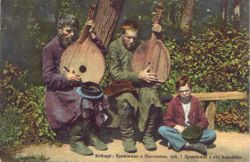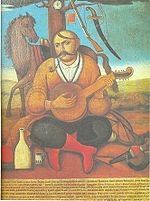
Kobzar
Encyclopedia


Tradition
Kobzars were often blind, and became predominantly so by the 1800s. Kobzar literally means ‘kobzaKobza
The kobza is a Ukrainian folk music instrument of the lute family , a relative of the Central European mandora...
player’, a Ukrainian stringed instrument of the lute
Lute
Lute can refer generally to any plucked string instrument with a neck and a deep round back, or more specifically to an instrument from the family of European lutes....
family, and more broadly — a performer of the musical material associated with the kobzar tradition.
The kobzar tradition was established during the Hetmanate Era
Cossack Hetmanate
The Hetmanate or Zaporizhian Host was the Ruthenian Cossack state in the Central Ukraine between 1649 and 1782.The Hetmanate was founded by first Ukrainian hetman Bohdan Khmelnytsky during the Khmelnytsky Uprising . In 1654 it pledged its allegiance to Muscovy during the Council of Pereyaslav,...
around the sixteenth century in Ukraine
History of Ukraine
The territory of Ukraine was a key center of East Slavic culture in the Middle Ages, before being divided between a variety of powers. However, the history of Ukraine dates back many thousands of years. The territory has been settled continuously since at least 5000 BC, and is also a candidate site...
. Kobzars accompanied their singing with a musical instrument known as the kobza
Kobza
The kobza is a Ukrainian folk music instrument of the lute family , a relative of the Central European mandora...
, bandura
Bandura
Bandura refers to a Ukrainian plucked string folk instrument. It combines elements of a box zither and lute, as well as its lute-like predecessor, the kobza...
or lira
Lira (instrument)
The lira, or relia, is a variant of the hurdy-gurdy, an instrument which can trace its history back to the 10th century. Regarding the origins of the lira in the region there are two schools of thought:...
. Their repertoire primarily consisted of para-liturgical psalms and "kanty", and also included a unique epic form known as dumas
Duma (epic)
A Duma is a sung epic poem which originated in Ukraine during the Hetmanate Era in the sixteenth century...
.
At the turn of the nineteenth century there were three regional kobzar schools: Chernihiv
Chernihiv kobzars
The Chernihiv kobzari were grouped around the city of Mena, in the Chernihiv Oblast of northeastern Ukraine. Outstanding members of this group were Pavlo Bratytsia, Andriy Beshko, Prokop Dub, Luka Dumenko, A...
, Poltava, and Slobozhan
Slobozhan kobzars
The kobzari of the Slobozhan bandura tradition were kobzari who lived in the Slobozhan region around the city of Kharkiv, Ukraine. They include Petro Drevchenko, Pavlo Hashchenko, Hnat Honcharenko, Horobetz, F. Hrytsenko-Kholodny, Hryhory Kozhushko, Ivan Kuchuhura Kucherenko, Ivan Netesa, Odnorih,...
, which were differentiated by repertoire and playing style.
Guilds
In Ukraine, kobzars organized themselves into regional guilds or brotherhoods, known as tsekhs. They developed a system of rigorous apprenticeships (usually three years in length) before undergoing the first set of open examinations in order to become a kobzar. These guilds were thought to have been modelled on the Orthodox Church brotherhoods as each guild was associated with a specific church. These guilds then would take care of one church icon or purchase new religious ornaments for their affiliated church (Kononenko, p. 568–9). The Orthodox Church however was often suspicious of and occasionally even hostile to kobzars.End of kobzardom
The institution of the kobzardom essentially ended in the Ukrainian SSRUkrainian SSR
The Ukrainian Soviet Socialist Republic or in short, the Ukrainian SSR was a sovereign Soviet Socialist state and one of the fifteen constituent republics of the Soviet Union lasting from its inception in 1922 to the breakup in 1991...
in the mid 1930s during Stalin's radical transformation of rural society which included the liquidation
Persecuted bandurists
Many bandurists and kobzars were persecuted by the authorities that controlled Ukraine at various times because of the association of the bandura to the Cossack past and aspects of Ukrainian history which the kobzars would glorify in their songs and epics.Kobzars were usually blind musicians, who...
of the kobzars of Ukraine. Kobzar performance was replaced with stylized performances of folk and classical music utilising the bandura
Bandura
Bandura refers to a Ukrainian plucked string folk instrument. It combines elements of a box zither and lute, as well as its lute-like predecessor, the kobza...
.
Re-establishment of the tradition
In recent times there has been an interest in reviving of authentic kobzar traditions which is marked by the re-establishing the Kobzar GuildKobzarskyi Tsekh
Kobzarskyi Tsekh - literaly "Kobzar guild" - is an organization of kobzars, which existed from the 17th century in Ukraine.Blind itinerant musicians, known as kobzars and lirnyks, organized themselves into guilds along the same lines as professional craftsmen...
as a centre for the dissemination of historical authentic performance practice.
Other use of the term
KobzarKobzar (book)
Kobzar , is a book of poems by Ukrainian poet and painter Taras Shevchenko, first published by him in 1840 in Saint Petersburg, Russia. Taras Shevchenko was nicknamed The Kobzar after the publishing of this book...
is also a seminal book of poetry by Taras Shevchenko
Taras Shevchenko
Taras Hryhorovych Shevchenko -Life:Born into a serf family of Hryhoriy Ivanovych Shevchenko and Kateryna Yakymivna Shevchenko in the village of Moryntsi, of Kiev Governorate of the Russian Empire Shevchenko was orphaned at the age of eleven...
, the great national poet of Ukraine
Ukraine
Ukraine is a country in Eastern Europe. It has an area of 603,628 km², making it the second largest contiguous country on the European continent, after Russia...
.
The term "kobzar" has on occasion been used for hurdy-gurdy players in Belarus
Belarus
Belarus , officially the Republic of Belarus, is a landlocked country in Eastern Europe, bordered clockwise by Russia to the northeast, Ukraine to the south, Poland to the west, and Lithuania and Latvia to the northwest. Its capital is Minsk; other major cities include Brest, Grodno , Gomel ,...
(where the hurdy-gurdy is often referred to as a "kobza", and bagpipe players in Poland
Poland
Poland , officially the Republic of Poland , is a country in Central Europe bordered by Germany to the west; the Czech Republic and Slovakia to the south; Ukraine, Belarus and Lithuania to the east; and the Baltic Sea and Kaliningrad Oblast, a Russian exclave, to the north...
where the bagpipe is referred to as a "kobza" or "koza".
External links
- Kobzar at Encyclopedia of Ukraine
- National Union of the Ukrainian Kobzars official site (in Ukrainian)
- Kobzari Music on Monitor Records at Smithsonian FolkwaysSmithsonian FolkwaysSmithsonian Folkways is the nonprofit record label of the Smithsonian Institution. It is a part of the Smithsonian's Center for Folklife and Cultural Heritage, located at Capital Gallery in downtown Washington, D.C. The label was founded in 1987 after the family of Moses Asch, founder of Folkways...
.

